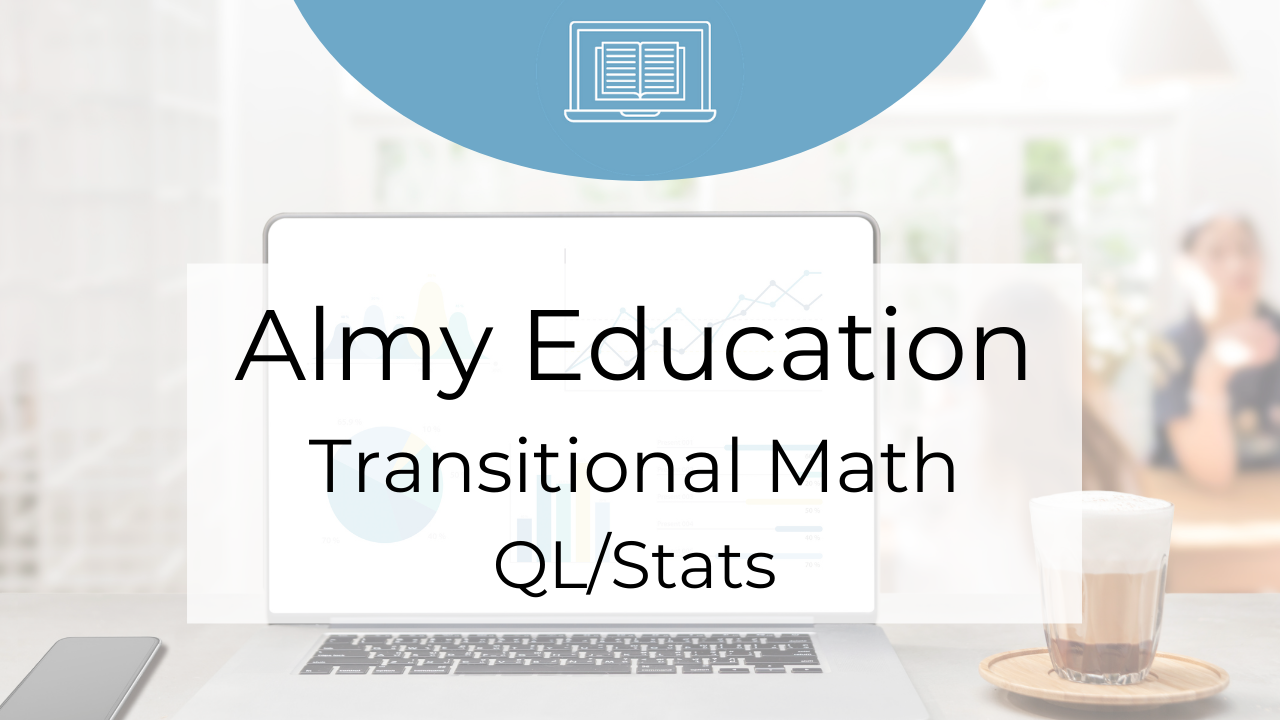Signed into law in 2016 in Illinois, the Postsecondary and Workforce Readiness Act (PWR) takes a student-based and competency-based approach to helping students achieve college and career readiness. While the PWR Act is composed of four strategies, we will focus solely on the requirement that the over 700 public Illinois high schools implement transitional math courses by the 2022-2023 school year.
If you are in Illinois and need help with your implementation, read on for tools you can use. If you are not in Illinois but are interested in the idea of transitional courses, this blog can give you ideas for what this intervention could be like in your state or school. In either case, reach out to Almy Education if you’re looking for implementation support.
What is Transitional Math?
Transitional courses provide high school seniors a chance to build any needed college readiness to succeed in math. Instead of using a college’s traditional developmental math courses, true transitional math courses employ new content and curricular approaches, such as contextualized curriculum. The result is students who not only have a better understanding of the material but who are engaged as well. But a good experience in an effective high school course isn’t enough. The final key feature of transitional math courses is the guaranteed placement a student receives upon successful completion at all Illinois community colleges and accepting Illinois universities. This placement is not based on a placement test or any high-stakes testing. Instead, it is based solely on a grade of C or better in a course with content and grading jointly agreed upon by high schools and colleges.
Community colleges and high schools partner to create courses that incorporate the required competencies and policies while emphasizing authentic learning experiences. Successful students are ready to be contributing members of their communities, are fully prepared for college, and are equipped with the traits employers seek. The benefits are significant. For example, if a student starts in a college-level math class, he’s much more likely to finish college. However, the flip side has similarly significant outcomes. If he starts in a developmental math class, his chances of graduating diminishes. This not only impacts his earning potential but his whole life.
So, what could be the problem with implementing transitional math? As mentioned earlier, the implementation of transitional math courses requires a K-12 to higher education partnership. This partnership includes the participation of multiple administrators, faculty, and student support professionals effectively communicating with one another. It not only demands a lot of trust and cooperation on both sides, but it requires a lot of intricate work, time, communication, and commitment. At a time when educators are already being stretched too thin, the implementation of such courses by the 2022-2023 school year feels even more challenging.
Some Solutions to a Transitional Math Problem
When the law passed, Kathleen Almy noticed that it tied into other college prep initiatives that she had been working on, including developmental math pathways. Knowing that the law had tremendous potential, Kathleen realized that it was unlikely to come to fruition as envisioned on its own. With such high stakes at risk, Kathleen approached the Illinois Community College Board, and the position of Illinois Director of Transitional Math was created.
In her new role for the state, Kathleen had zero budget and zero staff. Instead, she used her experience working with faculty and administrators and went to work. Noticing the considerable disconnect between K-12 and higher education, Kathleen instituted half-day summits that not only brought both groups in the partnerships up to speed on transitional math but also got them in the same room.
In addition to the more than 30 summits she held in 18 months, Kathleen created communication plans, monthly webinars and guided the creation of professional development resources, such as open educational resources. She also built templates, documents, and plans to reduce barriers and make transitional math implementation easier. She regularly spoke at events throughout the state to those affected by transitional math, gaining their perspectives and addressing their concerns. This included secondary and post-secondary levels as well as workforce development groups and policy groups.
Proven Transitional Math Resources That Work
In August 2019, Kathleen left her director position, going full-time with her consulting group. Due to her experience of working proficiently across all levels and her ability to get things done, Kathleen was contracted as a consultant by multiple Illinois colleges and high schools to help them implement transitional math at their campuses. Those experiences led her to create additional tools for high schools and colleges. She contracted other Illinois educators who were successful in each aspect of transitional math implementation, including compliance, instruction, and curriculum, to build out proven supports and training. They include teacher workgroups, curriculum, professional development for teachers, counselors, administrators, on-demand resources, custom consulting solutions, and tools to meet compliance requirements.

In one instance, after learning that teachers needed more support to implement the state’s free materials, Kathleen found teachers who had created original additions to the resources made for the Quantitative Literacy & Statistics pathway. She licensed the original content and contracted the teachers to manage a year-long teachers’ workgroup and provide intensive professional development. Now teachers have a very affordable way to implement the materials with the support they need. They also have an active workgroup where they exchange tools and advice between educators throughout the state.
When schools and colleges struggle with the issues that accompany this level of scale and partnership, Almy Education tackles those issues head-on. That means finding a variety of solutions, big and small, to meet the needs of high schools and colleges. Because of that, Kathleen and Almy Education’s current approach to implementation has been extremely successful.
Need Help With Your School’s Transitional Math Implementation?
Almy Education prides itself on helping not only educators and administrators but students. With colleges reporting numbers, such as a 37% percent decrease of students needing developmental education upon entering college, you can see the positive effects transitional math courses have on schools and their students.
Right now, Kathleen and her Illinois team are helping institutions implement transitional math by the 2022-2023 deadline. If you need help with implementation at any level, contact Kathleen. Check out Almy Education’s transitional math tools and training at www.almyeducation.com/transitionalmath.







